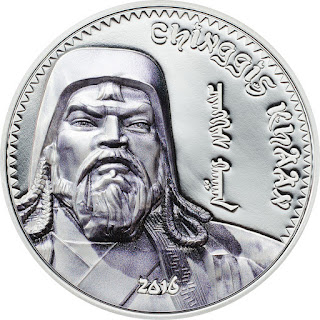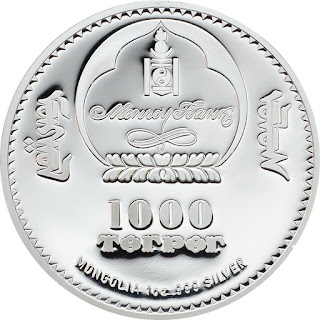Mongolia 1000 Tugrik Silver Coin 2016 Chinggis Khaan
Obverse: The obverse represents the Bank of Mongolia emblem and the inscriptions indicating the face value of the coin - "1000 Togrog". On the bottom of the obverse, the weight and fineness of Silver: “1 Oz 999 Silver”.
Lettering: Mонгол Банк 1000 ТӨГРӨГ MONGOLIA 1 oz .999 SILVER
Translation: The Bank of Mongolia - Monggol Ulus (Mongolia) 1000 Tögrög.
Reverse: The coin’s reverse depicts Genghis Khan with the face reproduction of the giant statue in the desert, near Ulaanbaatar, the capital of Mongolia. In the right side of the reverse, the inscriptions: “Chinggis Khaan” and “2016” – the year of issue.
Country: Mongolia.
Denomination:1000 Togrog.
Year: 2016.
Quality: Proof.
Metal: Silver .999.
Metal Content:1 troy oz.
Diameter: 38.61 mm.
Manufacturer: Mayer.
Mintage: 1000 pcs. worldwide.
Genghis Khan
Genghis Khan (c. 1162 – 18 August 1227), born Temüjin, was the founder and Great Khan (emperor) of the Mongol Empire, which became the largest contiguous empire in history after his demise.
He came to power by uniting many of the nomadic tribes of Northeast Asia. After founding the Mongol Empire and being proclaimed "Genghis Khan", he started the Mongol invasions that resulted in the conquest of most of Eurasia. These included raids or invasions of the Qara Khitai, Caucasus, Khwarezmid Empire, Western Xia and Jin dynasties. These campaigns were often accompanied by wholesale massacres of the civilian populations – especially in the Khwarezmian and Xia controlled lands. By the end of his life, the Mongol Empire occupied a substantial portion of Central Asia and China.
Before Genghis Khan died, he assigned Ögedei Khan as his successor and split his empire into khanates among his sons and grandsons. He died in 1227 after defeating the Western Xia. He was buried in an unmarked grave somewhere in Mongolia at an unknown location. His descendants extended the Mongol Empire across most of Eurasia by conquering or creating vassal states out of all of modern-day China, Korea, the Caucasus, Central Asia, and substantial portions of modern Eastern Europe, Russia, and Southwest Asia. Many of these invasions repeated the earlier large-scale slaughters of local populations. As a result, Genghis Khan and his empire have a fearsome reputation in local histories.
Beyond his military accomplishments, Genghis Khan also advanced the Mongol Empire in other ways. He decreed the adoption of the Uyghur script as the Mongol Empire's writing system. He also practiced meritocracy and encouraged religious tolerance in the Mongol Empire while unifying the nomadic tribes of Northeast Asia. Present-day Mongolians regard him as the founding father of Mongolia.
Although known for the brutality of his campaigns and considered by many to have been a genocidal ruler, Genghis Khan is also credited with bringing the Silk Road under one cohesive political environment. This brought communication and trade from Northeast Asia into Muslim Southwest Asia and Christian Europe, thus expanding the horizons of all three cultural areas.

